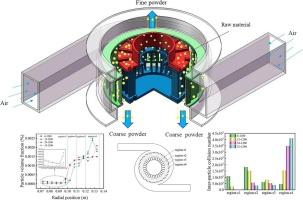基于 DSMC 的涡轮空气分级机中颗粒运动模型的建立和颗粒体积分数分布研究
IF 4.5
2区 工程技术
Q2 ENGINEERING, CHEMICAL
引用次数: 0
摘要
为了研究涡轮空气分级机流场中粒子的运动规律和碰撞行为,基于 Visual Studio,使用计算统一设备架构(CUDA)开发了粒子运动仿真平台。实现了粒子-涡流相互作用模型、粒子-壁面碰撞模型和粒子间碰撞直接模拟蒙特卡罗(DSMC)求解器。结果表明,与 DSMC、DDPM 和 DPM 相比,使用 DSMC 计算的切割尺寸 d50 与实验 d50 之间的偏差最小。与 DDPM 相比,DSMC 具有更好的加速性能。需要计算的颗粒越多,这一优势就越明显。分析了进料速率对颗粒体积分数和颗粒间碰撞数的影响。进料速率的增加会导致颗粒体积分数和颗粒间碰撞数的增加。本文章由计算机程序翻译,如有差异,请以英文原文为准。

Establishment of particle motion model and study of particle volume fraction distribution in the turbo air classifier based on DSMC
In order to study the particles' motion law and collision behavior in the flow field of the turbo air classifier, A particle motion simulation platform is developed using Compute Unified Device Architecture (CUDA) based on the Visual Studio. The particle-eddy interaction model, the particle-wall collision model, and the inter-particle collision Direct Simulation Monte Carlo (DSMC) solver are implemented. The results show that the deviation between calculated cut size d50 and experimental d50 using DSMC is smallest compared to DSMC, DDPM and DPM. DSMC has better acceleration performance compared to DDPM. The more particles need to be calculated, the more significant this advantage is. The influences of feeding rate on particle volume fractions and inter-particle collision number are analyzed. The increase of feeding rate leads to the increase of the particle volume fractions and inter-particle collision number.
求助全文
通过发布文献求助,成功后即可免费获取论文全文。
去求助
来源期刊

Powder Technology
工程技术-工程:化工
CiteScore
9.90
自引率
15.40%
发文量
1047
审稿时长
46 days
期刊介绍:
Powder Technology is an International Journal on the Science and Technology of Wet and Dry Particulate Systems. Powder Technology publishes papers on all aspects of the formation of particles and their characterisation and on the study of systems containing particulate solids. No limitation is imposed on the size of the particles, which may range from nanometre scale, as in pigments or aerosols, to that of mined or quarried materials. The following list of topics is not intended to be comprehensive, but rather to indicate typical subjects which fall within the scope of the journal's interests:
Formation and synthesis of particles by precipitation and other methods.
Modification of particles by agglomeration, coating, comminution and attrition.
Characterisation of the size, shape, surface area, pore structure and strength of particles and agglomerates (including the origins and effects of inter particle forces).
Packing, failure, flow and permeability of assemblies of particles.
Particle-particle interactions and suspension rheology.
Handling and processing operations such as slurry flow, fluidization, pneumatic conveying.
Interactions between particles and their environment, including delivery of particulate products to the body.
Applications of particle technology in production of pharmaceuticals, chemicals, foods, pigments, structural, and functional materials and in environmental and energy related matters.
For materials-oriented contributions we are looking for articles revealing the effect of particle/powder characteristics (size, morphology and composition, in that order) on material performance or functionality and, ideally, comparison to any industrial standard.
 求助内容:
求助内容: 应助结果提醒方式:
应助结果提醒方式:


